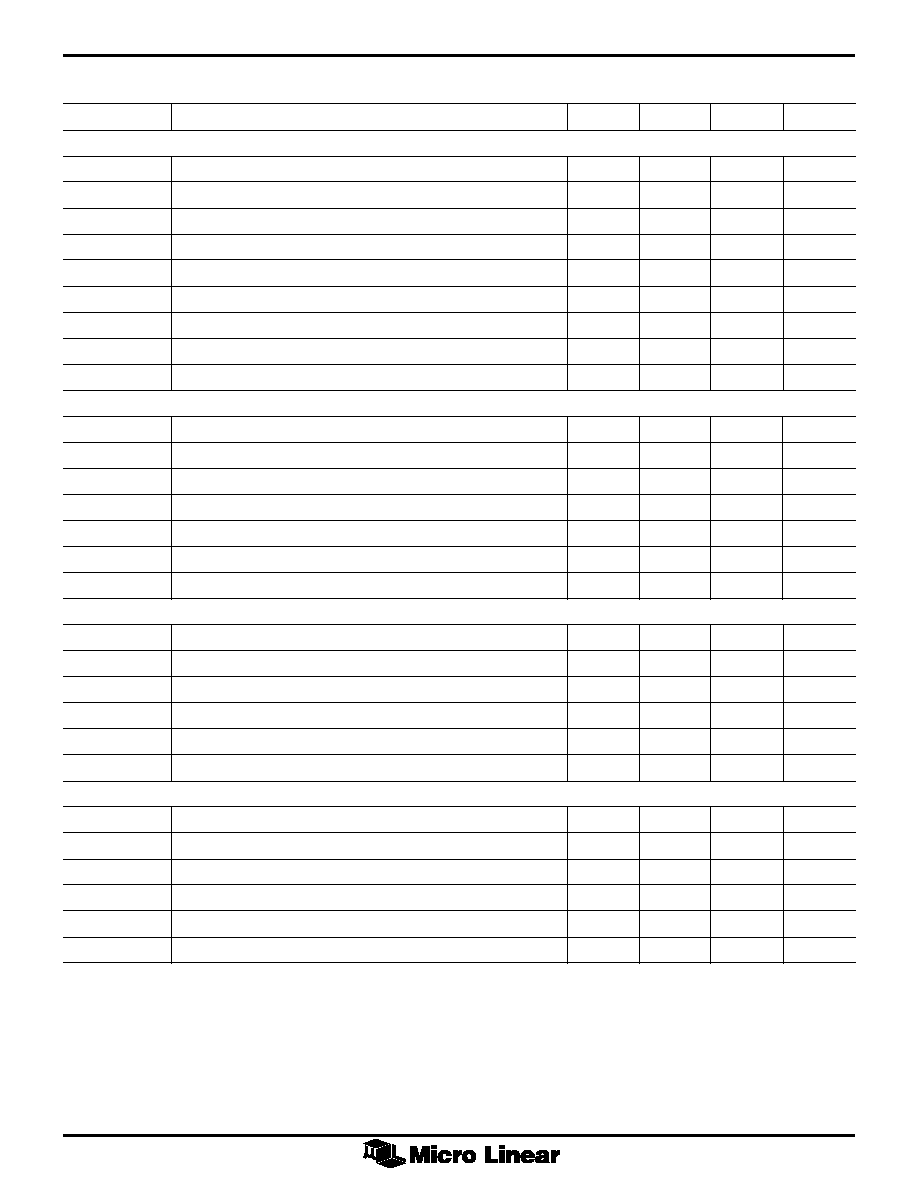 | –≠–ª–µ–∫—Ç—Ä–æ–Ω–Ω—ã–π –∫–æ–º–ø–æ–Ω–µ–Ω—Ç: ML4667 | –°–∫–∞—á–∞—Ç—å:  PDF PDF  ZIP ZIP |

March 1997
ML4667
Low Power 10BASE-FL Transceiver
GENERAL DESCRIPTION
The ML4667 is a low power high output current pin
compatible version of the industry standard ML4662. The
ML4667 10Base-FL transceiver combined with either the
ML4622 or ML4624 fiber optic quantizer provide all
functionality required to implement both an internal and
external IEEE 802.3 10Base-FL MAU interface that allows
it to be directly connected to industry standard
manchester encoder/decoder chips or and AUI cable.
The ML4667 provides a highly integrated solution that
requires a minimal number of external components. The
ML4667 is compliant to the IEEE 802.3 10Base-FL
standard. The transmitter offers a 100mA maximum
current driven output that directly drives a fiber optic LED
transmitter. Jabber, a 1MHz idle signal, and SQE Test are
fully integrated onto the chip.
The receiver accepts and ECL level input from the
ML4622 or ML4624 fiber optic quantizer. The 1MHz idle
signal is removed and the AUI output is activated when
the receive squelch criteria is exceeded. A Link Monitor
function is also provided for low light detection.
FEATURES
s
Combined with the ML4622 or ML4624, offers a
complete implementation of an 10Base-FL Medium
Attachment Unit (MAU)
s
Pin compatible with the ML4662 Transceiver
s
Incorporates an AU interface for use in an external
MAU or an internal MAU
s
100mA max LED output current drive
s
Single +5 volt supply
±
10%
s
No crystal or clock required
s
On-chip Jabber, 1MHz idle, and SQE Test with enable/
disable option
s
Five network status LED outputs
BLOCK DIAGRAM
1
RECEIVE SQUELCH
FREQUENCY
LINE
RECEIVER
LED
DRIVERS
LOOPBACK
MUX
AUI
DRIVER
AUI
DRIVER
10MHz GATED
OSCILLATOR
SQE
1MHz
IDLE
SIGNAL
Tx
SQUELCH
AUI
RECEIVER
FIBER OPTIC
LED DRIVER
JABBER
SQEN/JABD
V
CC
Tx
(+5V)
+5V
RTSET
NC/PEAK
TxOUT
LMON
IN
RxIN+
RxIN≠
BIAS
LMON
XMT
RCV
JAB
CLSN
LBDIS
RRSET
+5V
V
CC
(+5V)
GND
Rx≠
Rx+
COL≠
COL+
Tx≠
Tx+
Tx
Rx
10
11
2
3
6
7
21
8
13
23
1
28
16
15
24
27
25
26
22
18
19
17
4
12

2
ML4667
PIN CONNECTION
ML4667
28-Pin PLCC (Q28)
RxIN≠
LMON
LBDIS
LMON
IN
GND
GND
NC/PEAK
NC/GND
Rx+
Rx≠
V
CC
V
CC
Tx+
Tx≠
25
24
23
22
21
20
19
5
6
7
8
9
10
11
12 13 14 15 16 17 18
4 3 2 1 28 27 26
RTSET
RRSET
NC
XMT
RCV
V
CC
Tx
TxOUT
SQEN/JABD
COL≠
COL+
CLSN
JAB
BIAS
RxIN+

3
ML4667
PIN
NAME
FUNCTION
19
NC/PEAK
Normally this pin can be left
floating. (tying it to GND or V
CC
is
OK too.) Some fiber optic LEDs may
need an additional peaking circuit
to speed-up the rise and fall times.
For this case, tie pin 19 (NC/PEAK)
to pin 18 (TxOUT). When using the
HP HFBR 1414, let pin 19 float.
Using the peaking circuit may
deteriorate optical overshoot and
undershoot.
20
GND
Ground reference.
21
GND
Ground reference.
22
LMON
IN
Link Monitor Input from the
ML4622 or ML4624. This input
must be low (active) for the receiver
to unsquelch.
23
LBDIS
Loopback Disable. When this pin is
tied to V
CC
, the AUI transmit pair
data is not looped back to the AUI
receive pair, and collision is
disabled. When this pin is tied to
GND (normal operation), the AUI
transmit pair data is looped back to
the AUI receiver pair.
24
LMON
Link Monitor LED status output.
This pin is pulled low when
LMON
IN
is low and there are
transitions on RxIN
±
indicating and
idle signal or active data. If either
LMON
IN
goes high or transitions
cease on RxIN
±
,
LMON will go
high, Active low LED driver, open
collector.
25
RxIN≠
Fiber optic receive pair. This ECL
26
RXIN+
level signal is received from the
ML6422 or ML4624 fiber optic
quantizer. When this signal exceeds
the receive squelch requirements,
and the
LMON
IN
input is low, the
receive data is buffered and sent to
the AUI receive outputs.
27
BIAS
BIAS output voltage for the AUI
Tx+, Tx≠ inputs when they are AC
coupled.
28
JAB
Jabber network status LED. When in
the Jabber state, this pin will be low
and the transmitter will be disabled.
In the Jabber "OK" state this pin will
be high. Open collector TTL output.
PIN DESCRIPTION
PIN
NAME
FUNCTION
1
CLSN
Indicates that a collision is taking
place. Active low LED driver, open
collector. Event is extended with
internal timer for visibility.
2
COL+
Gated 10MHz oscillation used to
3
COL≠
indicate a collision, SQE test, or
jabber. Balanced differential line
driver outputs that meet AUI
specifications.
4
SQEN/JABD SQE Test Enable, Jabber Disable.
When tied low, SQE test is disabled,
when tied high SQE test is enabled.
When tied to BIAS both SQE test and
Jabber are disabled.
5
NC/GND
No connection. This pin may be
grounded.
6
Rx+
Manchester encoded receive data
7
Rx≠
output to the local device. Balanced
differential line driver outputs that
meet AUI specifications.
8
V
CC
+5 volt power input.
9
V
CC
10
Tx+
Balanced differential line receiver
11
Tx≠
inputs that meet AUI specifications.
These inputs may be transformer, AC
or DC coupled. When transformer or
AC coupled, the BIAS pin is used to
set the common mode voltage
12
RTSET
Sets the current driven output of the
transmitter.
13
RRSET
A 1% 61.9k
resistor tied from this
pin to V
CC
sets the biasing currents
for internal nodes.
14
NC
No Connection
15
XMT
Indicates that transmission is taking
place. Active low LED driver, open
collector. Event is extended with
internal timer for visibility.
16
RCV
Indicates that the transceiver is
receiving a frame from the optical
input. Active low LED driver, open
collector. Event is extended with
internal timer for visibility.
17
V
CC
Tx
+5 volt supply for LED driver.
18
TxOUT
Fiber optic LED driver output.

4
ML4667
ABSOLUTE MAXIMUM RATINGS
Absolute maximum ratings are those values beyond which
the device could be permanently damaged. Absolute
maximum ratings are stress ratings only and functional
device operation is not implied.
Power Supply Voltage Range
V
CC
..................................................... GND ≠0.3 to 6V
Input Voltage Range
Digital Inputs (SQEN, LMON
IN
, LBDIS)
.................................................. GND ≠0.3 to V
CC
+0.3
Tx+, Tx≠, RxIN+, RxIN≠ ............ GND ≠0.3 to V
CC
+0.3
Input Current
RRSET, RTSET,
JAB, CLSN, XMT, RCV, LMON ...... 60mA
Output Current
TxOUT .............................................................. 120mA
Junction Temperature .............................................. 150
∞
C
Storage Temperature Range .................... ≠65
∞
C to +150
∞
C
Lead Temperature (Soldering) .................................. 260
∞
C
Thermal Resistance (
JA
) ...................................... 68
∞
C /W
OPERATING CONDITIONS
Supply Voltage (V
CC
) ........................................... 5V
±
5%
LED on Current ....................................................... 10mA
RRSET .......................................................... 61.9k
±
1%
RTSET ............................................................. 162
±
1%
ELECTRICAL CHARACTERISTICS
Unless otherwise specified, T
A
= Operating Temperature Range, V
CC
= 5V
±
10% (Note 1)
SYMBOL
PARAMETER
CONDITIONS
MIN
TYP
MAX
UNITS
I
CC
Power Supply Current I
CC
:
V
CC
= 5V, RTSET = 162
(Note 2)
120
mA
While Transmitting
V
OL
LED Drivers
I
OL
= 10mA (Note 3)
0.8
V
I
OUT
Transmit Peak Output Current
RTSET = 162
,
47
52
60
mA
V
CC
= V
CC
Tx = 5V
±
5% (Note 4)
V
SQ
Transmit Squelch Voltage Level
≠300
≠250
≠200
mV
(Tx+, Tx≠)
V
INCM
Common mode Input Voltage
2
V
CC
≠ 0.5
V
(Tx
±
, RxIN
±
)
V
DO
Differential Output Voltage
±
550
±
1200
mV
(Rx
±
, COL
±
)
V
CM
Common Mode
4.0
V
Output Voltage (Rx
±
, COL
±
)
V
DOO
Differential Output
±
40
mV
Voltage Imbalance (Rx
±
, COL
±
)
V
BIAS
BIAS Voltage
3.2
V
V
SQE
SQE/JABD
SQE Test Disable
0.3
V
Both Disabled
1.5
V
CC
≠ 2
Both Enabled
V
CC
≠ 0.5
V
LBTH
LBDIS Threshold
Disabled
V
CC
≠ 0.10
V
Enabled
1
V

5
ML4667
AC ELECTRICAL CHARACTERISTICS
SYMBOL
PARAMETER
MIN
TYP
MAX
UNITS
TRANSMIT
F
TXIDF
Transmit Idle Frequency
0.85
1.25
MHz
P
TXDC
Transmit Idle Duty Cycle
45
55
%
t
TXNPW
Transmit Turn-On Pulse Width
20
ns
t
TXODY
Transmit Turn-On Delay
200
ns
t
TXLP
Transmit loopback Start up Delay
500
ns
t
TXFPW
Transmit Turn Off Pulse Width
180
ns
t
TXSOI
Transmit Start of Idle
400
2100
ns
t
TXSDY
Transmit Steady State Propagation Delay
15
50
ns
t
TXJ
Transmit Jitter into 31
Load
±
1.5
ns
RECEIVE
F
RXSFT
Receive Squelch Frequency Threshold
2.51
4.5
MHz
t
RXODY
Receive Turn-On Delay
270
ns
t
RXFX
Last Bit Received to Slow Decay Output
230
300
ns
t
RXSDY
Receive Steady State Propagation Delay
15
50
ns
t
RXJ
Receive Jitter
±
1.5
ns
t
AR
Differential Output Rise Time 20% to 80% (Rx
±
, COL
±
)
4
ns
t
AF
Differential Output Fall Time 20% to 80% (Rx
±
, COL
±
)
4
ns
COLLISION
t
CPSQE
Collision Present to SQE Assert
0
350
ns
t
SQEXR
Time for SQE to Deactivate After Collision
0
700
ns
F
CLF
Collision Frequency
8.5
11.5
MHz
P
CLPDC
Collision Pulse Duty Cycle
40
50
60
%
t
SQEDY
SQE Test Delay (Tx Inactive to SQE)
0.6
1.6
µ
s
t
SQETD
SQE Test Duration
0.5
1.0
1.5
µ
s
JABBER AND LED TIMING
t
JAD
Jabber Activation Delay
20
70
150
ms
t
JRT
Jabber Reset Unjab Time
250
450
750
ms
t
JSQE
Delay from Outputs Disabled to Collision Oscillator On
100
ns
t
LED
RCV, CLSN, XMT On Time
8
16
32
ms
t
LLPH
Low Light Present to
LMON High
3
5
10
µ
s
t
LLCL
Low Light Present to
LMON Low
250
750
ms
Note 1: Limits are guaranteed by 100% testing, sampling, or correlation with worst-case test conditions.
Note 2: This does not include the current from the AUI pull-down resistors, or LED status outputs.
Note 3: LED drivers can sink up to 20mA, but V
OL
will be higher.
Note 4: Does not include prebias current for fiber optic LED which would typically be 3mA.




